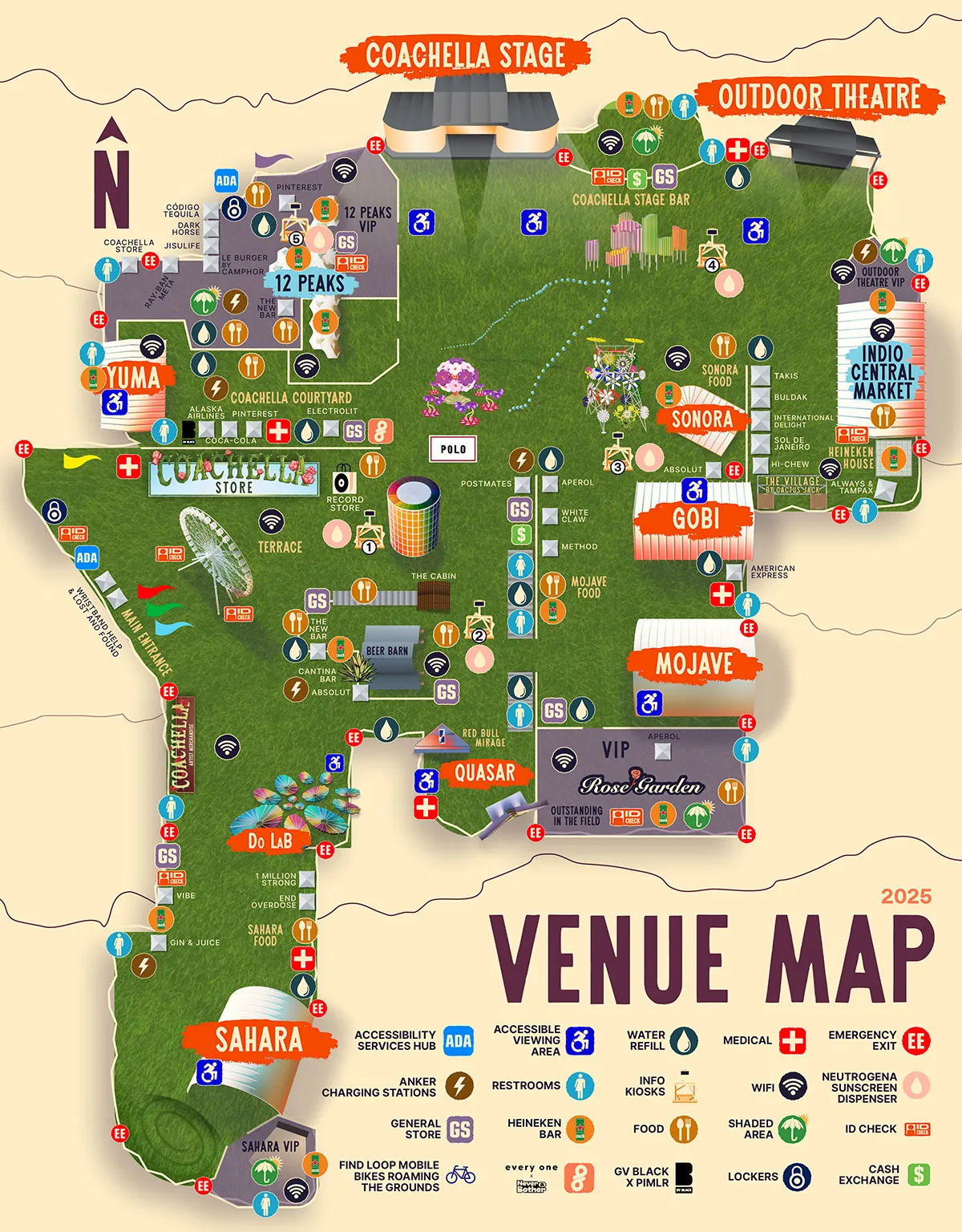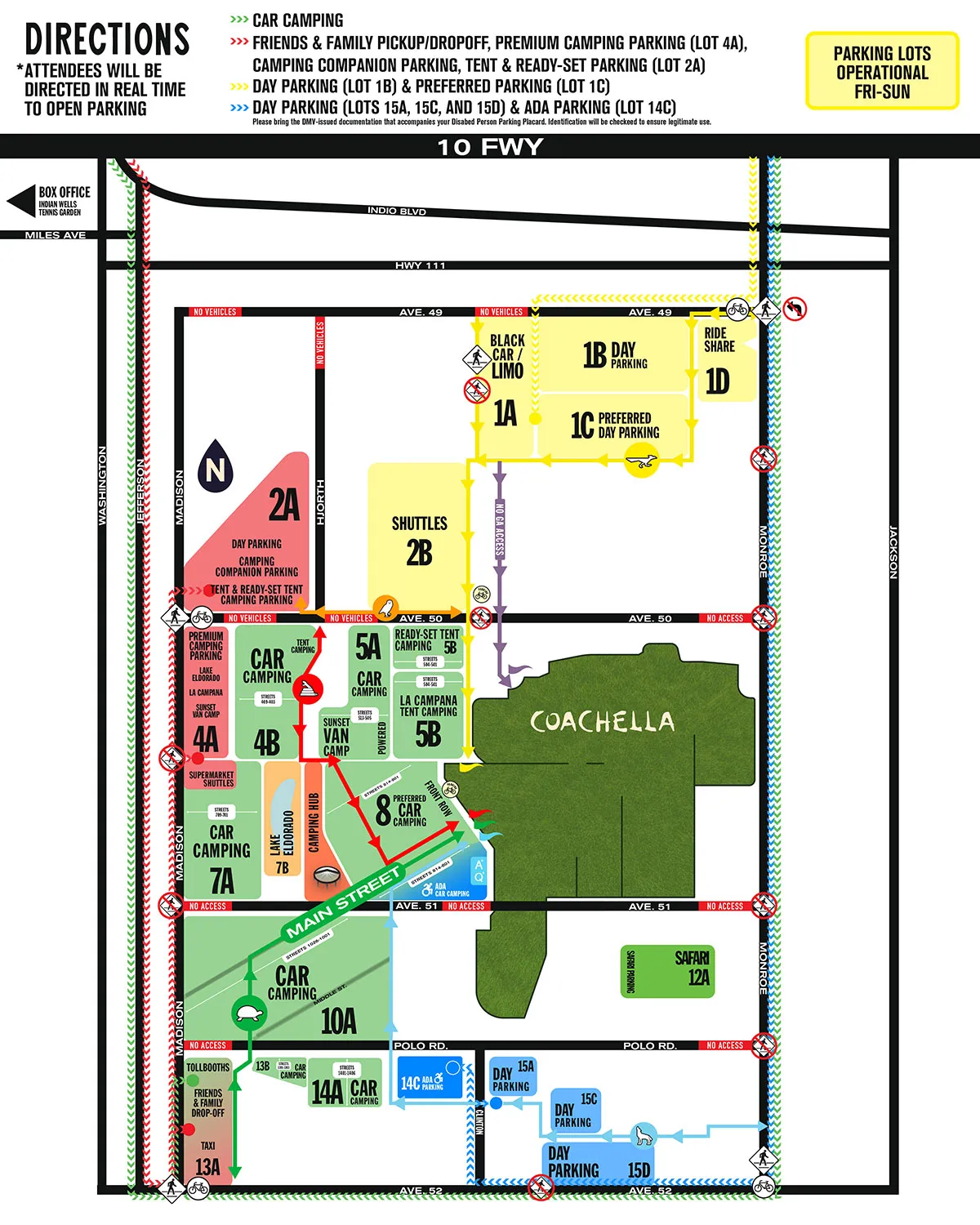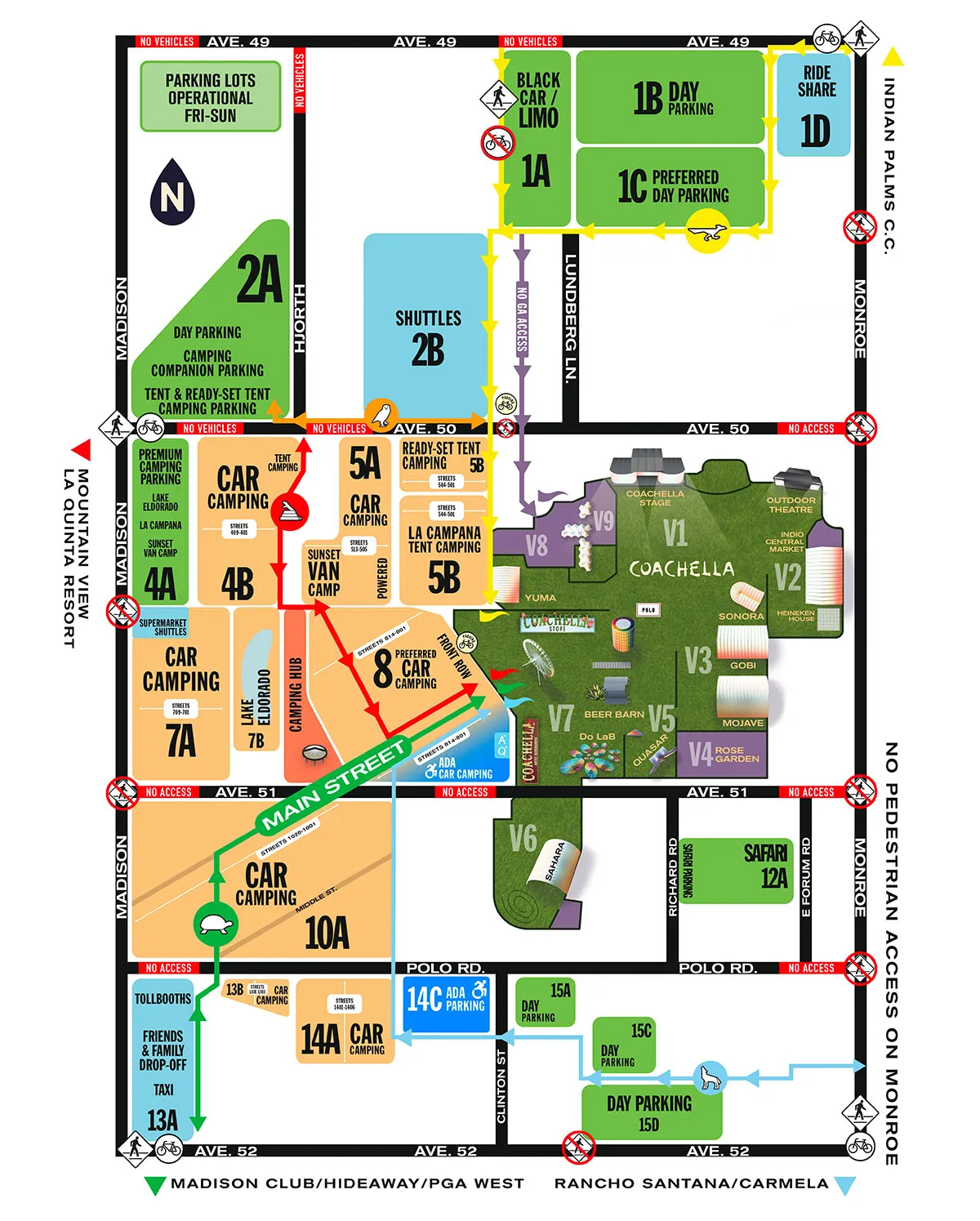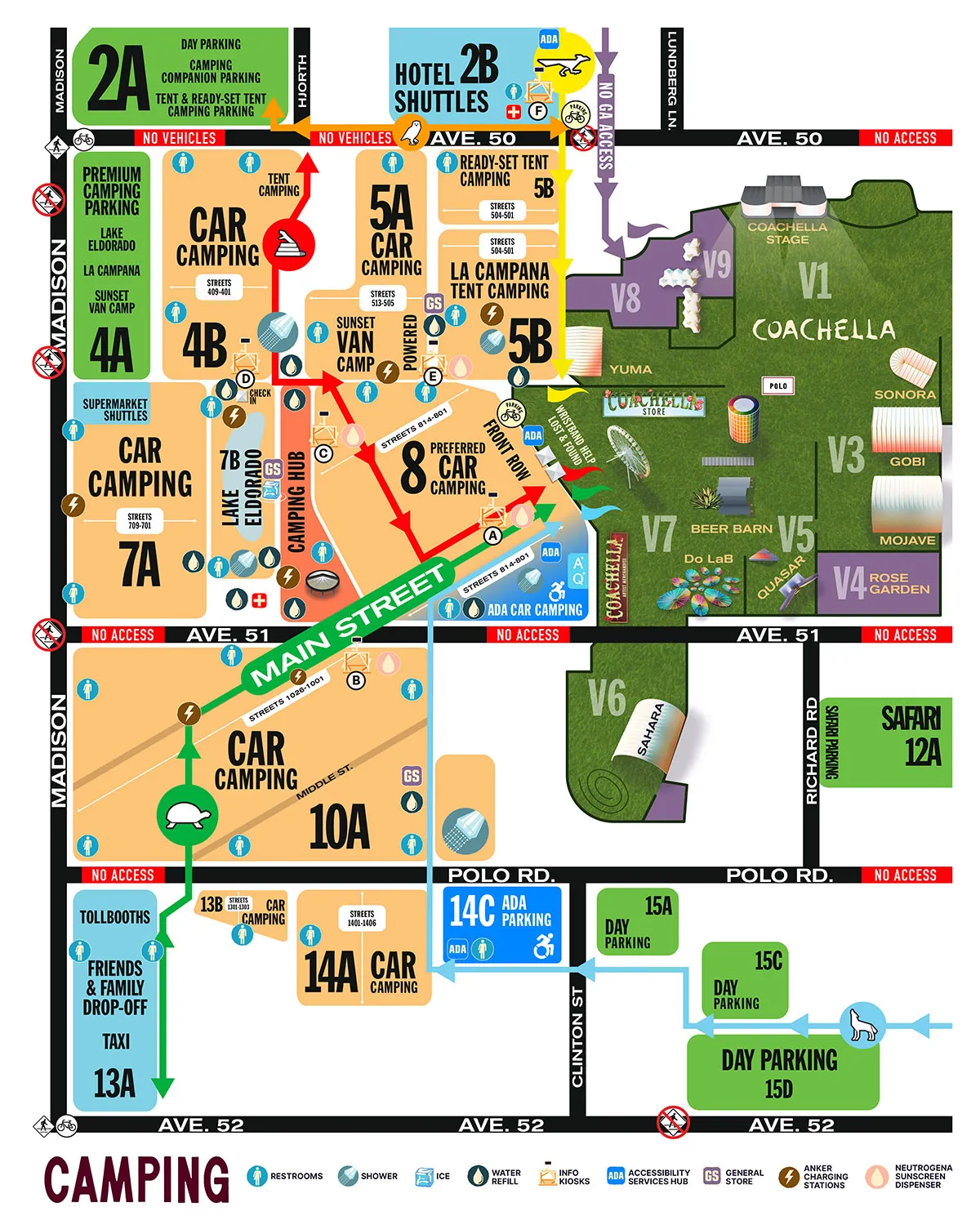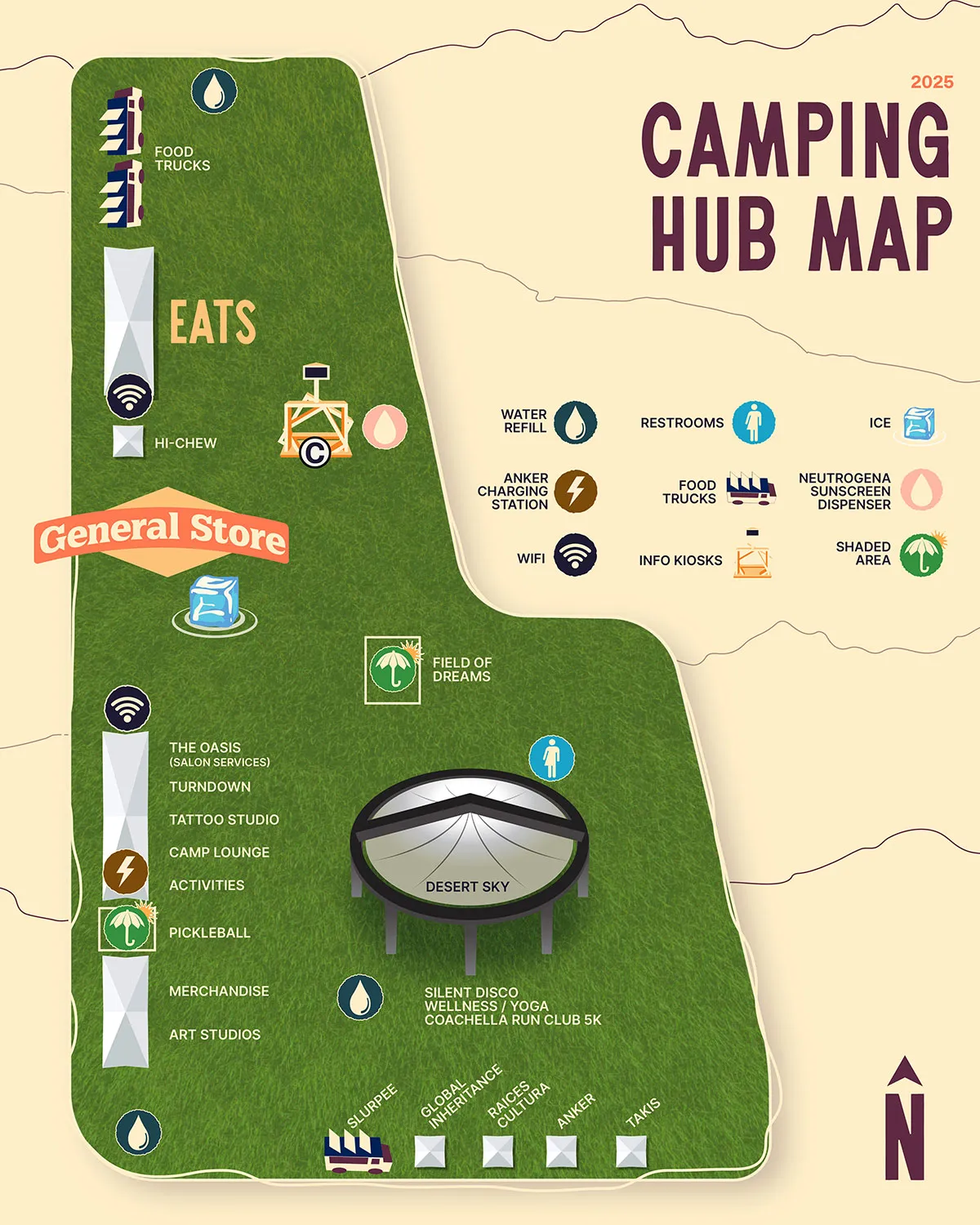2025 Coachella Guide
Last Update | April 8th, 2025 | 22:39 CET
Welcome to our 2025 Coachella Guide! This guide will, as the name says, "guide" you through various aspects of Coachella. We will answer the who, what when and why's of the upcoming edition based on crowdsourced knowledge from avid Coachella festival goers. Feel free to scroll through various aspects on this page, or use the index below to jump to a section of this guide. Enjoy!
Current FAQ
What are the Dates for Coachella 2025?
Weekend 1: April 11th - 13th, 2025
Weekend 2: April 18th - 20th, 2025
When does the Coachella 2025 Ticket Sale start?
The sale has already started
When will the full Line-Up be announced?
The 2025 line-up has been announced!
Are the set times available yet?
The set times have been announced! Check them out below.
Index
Instead of scrolling, you can quickly jump to a section of this page my clicking the links below!
Ticket Types & Prices
We have a dedicated page that lists most of the expected ticket types and prices from the past edition. Typically, a Coachella GA pass starts at 549$ (incl. parking), while a camping pass with either your car or just a tent starts at an additional 179$. If you would like a VIP experience, park closer to the festival site or camp in a more luxorious way, the cost is naturally higher.
Common FAQ
- When is the lineup released? - It's usually released early January. For instance, this year it was released on January 10th, 2023.
- When do tickets go on sale? - Presale for 2023 tickets began on June 17th 2022, with the general sale starting right after the lineup is announced. Presale for the following year is typically in May.
- When are set times announced? - Set times are usually shared just a few days before the festival.
- Why haven’t my tickets shipped yet? - No need to panic unless you’re getting into April and haven’t received a shipping email. If they don't arrive on time, you can pick them up at will call.
- Is the leaked lineup on Instagram real? - No, those leaked lineups are typically false.
- Can I opt for a payment plan during the regular sale? - Yes, they now offer a payment plan at general sale which includes two 50/50 payments.
- What's the difference between pricing tiers? - It's mainly a marketing strategy to incentivize people to buy as soon as possible. The different "price tiers" don’t offer any additional benefits, unlike the “ticket type tiers” such as VIP, guest, artist, etc.
- Do I have to buy my camping pass with my ticket? - No, you can buy them separately and even trade/sell camping passes.
- Can I get a single-day pass? - Unfortunately, no. The only way to attend for a single day would be to find someone willing to sell a single day use of their wristband.
- Do I really have to pick up my travel package ticket at will call? - Depending on the package, it’s either will call or your hotel / resort.
- Are Lyte / StubHub / Festicket legitimate platforms? - Yes, they are all reputable ticket selling platforms.
- If I get on the waitlist, how long will it take to get a ticket? - It's hard to say as it entirely depends on the supply and demand.
- Do I need to have a car in each car camping spot? - Yes, you do.
- Can I sleep in my car? - Yes, but it can get very hot. It's advisable to cover the windows and/or put a canopy over the car for shade.
- What is the driving experience from LAX like? - It can be quite challenging due to unpredictable traffic. It's highly recommended to avoid arriving on Friday morning or leaving on Monday morning.
- What if I have to leave Sunday night right after the show? - You can pack up and move your car to general parking before 9pm and leave from there whenever you want to.
- How big is the car camping spot? - The spots measure 10x30 feet or approximately 3x9.15 meters.
- How many people can fit in a car camping spot? - You can fit as many people as you'd like, but typically, a group of three is the most comfortable.
- What should I do if I can’t park at my lodging? - You can buy a companion parking pass to park your car all weekend in a lot adjacent to car camping.
- What should I do if I don’t have camping gear? - You have several options, such as renting a camper van, buying or renting gear, taking a shuttle, or sharing gear with a group.
- How do I secure the best camping spot? - Arriving as early as possible and monitoring social media for updates can increase your chances of getting a good spot.
- Can I bring an RV? - No, RVs are not permitted.
- Can I bring a totem into the venue? - No, totems are not allowed.
- Can all the cars in my group camp together? - Yes, but your group has to enter around the same time and can't save spots.
- Does VIP access include backstage or closeup viewing areas? - No, VIP access doesn't include these perks.
- Can I enter the camping area if I don’t have a camping pass? - Yes, you can.
- What if my wristband is at will call and I can't go? - Officially, only the original purchaser can pick up the wristband at will call.
- Can I bring weed since it's legal in California? - No, it's not allowed at the festival.
- How do shuttles work? - There are different shuttle passes for LAX, the festival, and a free shuttle for the camping area.
- Is there Wi-Fi available if I need to work or study? - There's Wi-Fi at the camp center, but it's not very reliable. It's safer to find a local coffee shop.
- Can I camp if I’m under 18? - Only if you have a parent or legal guardian with you.
- When should I book lodging? - The sooner, the better.
- What are the chances of a certain artist performing? - No one knows until the lineup is announced.
- What is the "radius clause"? - It's an agreement that restricts artists from performing in the vicinity of the festival for several months before and after it.
- Which weekend is better? - It's subjective, as there are pros and cons to each weekend.
- Should I go solo? - Absolutely! It can be a rewarding experience.
Festival Survival Tips
Preparation and Planning
- Festival Homework: Research who you want to see at the festival and plan your schedule accordingly, factoring in overlaps and travel times between stages. It's important to study the festival schedule meticulously once it's released.
- Travel Logistics: Always account for a 15-20 minute travel time between stages. Be prepared to make some sacrifices and make peace with that fact early on.
- Establish Meeting Spots: On the first day of the festival, set up meeting spots at each stage with your group for the entire weekend. Use labelled speaker towers, like "B1" or "A6", to your advantage.
Accommodation and Transportation
- Camping: Camping is a cheaper and more convenient alternative. Even while camping, you can still enjoy pool parties, showers, and avoid spending excessively on accommodations far from the venue.
- Uber Timing: If you're not camping, do not wait until late in the day to book an Uber. Surge pricing could be extremely high.
- Vehicle Management: When arriving, keep a track of where you are keeping your car keys. Also, if charging your phone in the car, ensure to turn the car on to avoid draining the battery.
Food and Drinks
- Eating Habits: Don't skip meals to maintain a slim look. It could lead to passing out and potentially missing performances.
- Healthy Start: Start the day with some fruit for essential vitamins and energy (Not necessarily energy drinks that is ;)).
- Food Choices: Always keep a healthy balance between carbs, proteins and fibers. Avoid heavy foods like pulled pork and foods that don't give you base like sushi in the heat.
- Drink Water: Stay hydrated by drinking water first thing in the morning and before sleeping. Carry enough bottles to share with friends.
- Alcohol Management: Invest in discreet flask options to carry your own alcohol. Be creative with options like wine bras or hidden-alcohol tubes.
Entertainment and Relaxation
- Do Lab Visit: Don't skip the Do Lab. It's the best place to cool down and enjoy a refreshing atmosphere.
- Stage Management: Don't stay at one stage the whole weekend. Explore other tents like the Yuma tent which has air conditioning.
- Ferris Wheel Experience: Spare time to ride the ferris wheel early in the morning when the lines are short. The view is life-changing.
Attire and Personal Care
- Clothing Choices: Avoid neon colors and high heels. Wear shoes to avoid stepping on harmful objects. Also, use your "beater-shoes". Your Nike Air Force 1s are going to be anything but white after the first day.
- Skin Care: Don't use metallic temporary tattoos or facepaint on your face as they could leave tan lines.
- Hair Care: Ladies, bring de-tangler as hair can get dirty quickly.
Miscellaneous
- Managing Expectations: Remember, you don't need to be in the center of every crowd. Learn to appreciate some space and good sound.
- Mobile Phone Management: Don't stress if your phone dies. It's part of the experience. That being said, a small power bank could help. Don't be on you phone too much and just enjoy the experience.
- Respect Environment: Pick up your trash. Keep the festival clean for everyone.
Overall Safety and Enjoyment
- Moderation is Key: Enjoy the festival, but remember to do everything in moderation. Be safe, look after each other, and have fun.
Camping Essentials Packing List
Mandatory
- Wristband and camping pass: Necessary for festival entry, car camping and individual identification.
- Sunscreen: A must-have for the desert weather. Handy to have smaller, easy-to-carry packs.
- Basic and warm clothes: Include fresh undergarments for each day, light jacket, and comfortable outfits.
- Comfortable shoes: Prioritize functionality and comfort. Break them in before the festival.
- Earplugs: Essential for loud music areas. Invest in quality options for comfort and hearing protection.
- Identification: Leave ID in a secure place like a locked car after acquiring the 21+ wristband.
- Money: Carry both physical and digital forms of money for convenience.
- Bedding: Consider sleeping bags or warm blankets for rest.
- Canopy: Protect yourself from sunlight with a decent straight-legged canopy.
- Tent stakes: Plastic stakes are essential for tent and canopy stability, metal ones are prohibited.
- Water: 2-4 bottles per person per day recommended.
- Food: Carry emergency snacks and possibly cooking essentials if needed.
- Face coverings: Vital for protection against airborne diseases and dust. Various options available to suit comfort.
Suggested
- Alcohol: If you enjoy drinking, bring enough for your group. Remember to follow regulations regarding alcohol quantities.
- Electrolytes source: Helps avoid dehydration and hangovers.
- Cooking utensils: Non-metal options preferred if you plan to cook.
- Tent: A personal choice depending on comfort levels. Useful for those with dust allergies.
- Air mattress and pump: Offers more comfort than sleeping on the ground and helps retain warmth.
- Jumper cables: Useful for any car battery issues.
- Backup essentials: Keep extra car keys, contacts/glasses, wipes and toiletries handy.
- Hygiene essentials: Include SPF chapstick, hand sanitizer, chafing reduction products, and deodorant.
- Saline nasal spray/rinse: Clears sinuses from dust.
- Hydration packs: Preferable to carry 2L or less.
- Fanny pack: A great accessory for convenience and safety against pickpocketing.
- Lighting: Essential for late-night bathroom trips and general campsite illumination.
- Hat and/or sunglasses: Protects against sunlight.
- Campsite decorations: Tapestries, canopy walls, sheets, tarps, etc. for shade and privacy.
- Cooler: Helps keep water and perishables cool and fresh.
- Sleeping aids: Earplugs and eye mask for quality rest.
- USB power bank: Keeps your devices charged.
- Folding tables and chairs: Provides seating and surface area for activities like beer pong.
- Digital watch: Convenient for checking time without reaching for your phone.
Luxuries
- Kiddie pool and misters: Great for fun and cooling down.
- Unique decorations: Helpful for locating your campsite.
- Comfortable blankets/bathrobes: Ideal for evening hangouts.
- Cooling eye mask: Assists in rest and cooling down.
- AstroTurf / carpet: Useful for a cleaner campsite surface.
- Menthol inhaler sticks: Useful for a refreshing experience.
- Gum/candy, light diffraction glasses: Enhances festival fun.
- Bluetooth speaker: Provides personal entertainment, with caution on volume levels.
Camping Tips
Arrival
- Setup: Ensure to conduct a thorough review of your camping equipment and space prior to leaving home. This aids in identifying any overlooked or damaged items such as broken tent poles, malfunctioning air mattress pumps, etc. Also, ascertain that everything can fit into your vehicle and that your campsite space is adequate.
- Parking: Upon arrival, parking attendants will guide you to your allocated spot. If you're in a group, try to space the cars as far apart as possible to maximize available space.
- Relax and take in the moment: Once you have settled in, take a moment to appreciate your surroundings. It is also the perfect time to open a beer and take in the campsite ambiance.
- Erecting your canopy: Set up your canopy first to provide shade as you continue setting up. Should you have multiple canopies, align them together to increase your shade coverage.
- Identify the sun's path: Determine the sun's trajectory to predict where shade will be available in your campsite throughout the day. Position any available tarps or sheets to block the morning sun.
- Position your tent/sleeping area: Place your tent or sleeping area where it will benefit from morning shade. Don't forget to secure your tent by staking it down.
- Set up tables and chairs: Arrange your tables and chairs under the remaining shade. If you plan on cooking, allocate a section of your space as the cooking area.
- Arrange your trash management: Set up your trash bags in a secure and convenient location. Ensure to tie it well to avoid wind-related litter scattering.
- Familiarize yourself with the surroundings: Get acquainted with the camp center and the facilities around your campsite. Look for landmarks that can help you find your way back to your site. Don't forget to note where the nearest toilets, showers, and water points are.
- Prepare for high winds High winds can be unpredictable and cause havoc on unprepared campsites. Make sure to secure everything and consider lowering your canopy to reduce wind resistance.
- Camping options for those traveling from afar: Various options are available for those who don't own camping equipment or are traveling from distant locations. Services like RV rentals or purchasing camping gear on arrival are available.
- Caravan into car camping: Plan to arrive with your group simultaneously and remain together as you pass through security checkpoints. Once through security, follow signs to the group waiting area to regroup and move on to the campsites.
Food & Sleeping
- Food and cooking: Propane is the only permitted cooking fuel. There are many stove options to choose from. Consider preparing meals that require less perishable ingredients first.
- No cooking needed foods: There are plenty of food options that require no cooking and no refrigeration. These can include sandwiches, fruits, veggies and hummus, nuts, protein bars, and others.
- Sample cooking menu: Design a menu that ensures perishable items are consumed first. This menu could include meals like burgers or fajitas, breakfast burritos, cold cut sandwiches, hot dogs, and more.
- Sleeping: Ensure to get enough rest despite the possible noise from neighboring campsites. You can use over-the-counter medications to help with sleep, earplugs to block out noise, and bring comfortable items from home to help with sleeping.
Stages
Coachellas stages change a little bit year by year. You can see the most recent stages with a small description of what they are about below!
Coachella Mainstage
The Coachella Mainstage is known for its grandeur and extravagance, hosting some of the biggest names in the global music industry. In the past, acclaimed artists like The Weeknd and Swedish House Mafia have graced this stage, delivering unforgettable performances. The Mainstage is where Coachella's audiovisual production is at its peak, creating memorable spectacles every year. It's the heart of the festival, buzzing with activity and surrounded by an array of amenities that cater to the audience's needs. This stage has seen many iconic performances and continues to be a major attraction for festival-goers.
Outdoor Theatre
The Outdoor Theatre is a smaller yet equally enchanting stage not far from the Mainstage. Offering a more intimate experience, this stage has welcomed many eminent industry figures. Its setup closely mirrors the Mainstage, albeit on a smaller scale, without compromising on production quality. The Outdoor Theatre is an ideal spot for enjoying a picturesque sunset at Coachella Valley while indulging in fantastic music performances. It also offers a live-streaming option for those who wish to enjoy the festival from the comfort of their homes.
Mojave Tent
The Mojave Tent is a haven for those looking to escape the relentless sun. It typically hosts indie and rock bands, paying homage to Coachella's roots. While its indoor setup limits the production capabilities compared to the Mainstage and Outdoor Theatre, the Mojave Tent retains a vivacious atmosphere. Attendees can look forward to discovering new talents in a refreshing, sheltered environment at the Mojave Tent.
Sahara
The Sahara Tent, reminiscent of the Ultra Worldwide stage, is an enormous archway that traditionally hosts electronic artists and DJs. The unique structure of this stage allows for an immersive 360-degree production approach, leading to engaging and memorable performances. The Sahara Tent is widely recognized as one of Coachella's staple stages, featuring a dynamic combination of lasers, lights, and pyrotechnics that add to the exhilarating atmosphere.
Do Lab
The Do Lab is a vibrant, colorful retreat from the desert heat, showcasing emerging electronic artists from niche genres. Covered in multicolored canopies, this stage creates a sensory overload, amplified by the playful use of water guns that cool down the audience. The Do Lab is a delightful blend of music and interactive entertainment, ensuring a unique festival experience.
Yuma & Sonora Tents
The Yuma and Sonora Tents are tucked away in quieter parts of the festival grounds, offering air-conditioned comfort to festival-goers. These stages are the hub for underground talents, providing a tranquil space to enjoy music away from the festival's hustle and bustle. Although these stages have controlled capacities, the Yuma and Sonora Tents undoubtedly offer a comprehensive Coachella experience, complete with riveting performances from up-and-coming music stars.
